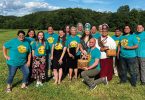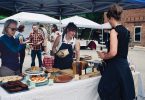By Gina Malone

Marcie Cohen Ferris
When North Carolinians seat themselves at Thanksgiving tables this month, a rich spread of heritage foods unique to their families and birthplaces will likely be laid out before them. Some of the stories behind our favorite, handed-down dishes can be found in a new book of essays, photographs and recipes that explore the Old North State from its coastal regions to the mountains. University of North Carolina professor emeritus, author and food historian Marcie Cohen Ferris edited Edible North Carolina: A Journey Across a State of Flavor, which grew out of a course she taught at UNC-Chapel Hill on food cultures. Students conducted oral histories with food producers and entrepreneurs across the state, gathering a wealth of information about past and present food traditions.
“Food policy specialists, aggregators, farmers, chefs, fishermen and more visited our class as guest lecturers,” says Ferris. “It was clear that an important book was at the heart of this work which became Edible North Carolina.” Ferris’ many years exploring food traditions and meeting members of the state’s “incredibly connected and complex food family” contributed to the book’s going beyond a collection of recipes and stories to address food issues as well in thoughtful essays. “Journalists, chefs, farmers, extension agents, food activists and scholars are deeply informed about the substantive issues at the core of the contemporary food movement,” she says.
 Ferris, who has lived in NC for more than 20 years, has a longstanding relationship with the study of food. “I have always seen the world through the lens of food,” she says. “I followed food into the world of public history and then into academia where I’ve explored the complex and fascinating food landscapes of the American South.” In 2018, she was awarded the Southern Foodways Alliance’s Craig Claiborne Lifetime Achievement Award.
Ferris, who has lived in NC for more than 20 years, has a longstanding relationship with the study of food. “I have always seen the world through the lens of food,” she says. “I followed food into the world of public history and then into academia where I’ve explored the complex and fascinating food landscapes of the American South.” In 2018, she was awarded the Southern Foodways Alliance’s Craig Claiborne Lifetime Achievement Award.
Reflecting on NC’s history, it is not surprising that there exists such diversity in the state’s food heritage. “After the passage of the Immigration Act in 1965, which ended the restrictive and racist American immigration quotas established in the late 19th century, NC became a place of refuge for people seeking safe haven, economic opportunity and education for their children,” Ferris says. “In the 1990s, growing numbers of immigrants from Mexico and Latin America, India, the Middle East and Asia came to NC. Their food cultures deeply impacted the foundational food cultures in our state shaped by the Indigenous peoples in this region and European settler colonialists who arrived in NC in the 1700s.”

Malinda Maynor Lowery’s Collard Sandwich. Photo by Baxter Miller
Topics and peoples touched on by the book’s essays include commercial fishing, comfort and working-class food, agriculture, culinary scenes, and contributions by Affrilachian, Latino, Lumbee, Chinese and other populations, and the recipes included range well beyond what may be thought of as traditional southern dishes. “The recipes are important cultural expressions of agency, creativity, memory, heritage and evolving traditions, flavors, ingredients and food methodologies at home and in food-related businesses,” says Ferris.
In her courses, Ferris examined food as an “expressive language.” It can also, she says, “unite us as a region, a state, and on occasions, as a nation. At the same time, food reveals sharp divisions in American society and points to inequity in food access and the essential right for all human beings to have safe, affordable, seasonal, locally grown food that both supports good health and builds a working local, food economy.”
Along with an appreciation for NC’s food cultures and some new and traditional recipes, Ferris hopes that readers of Edible North Carolina find joy in the range of food and beverages intrinsic to the state but also realize a sense of the activism needed for food justice here as elsewhere around the country. “As knowledgeable consumers, we can support our local food entrepreneurs by shopping and eating locally, voting for candidates who understand the critical importance of affordable, healthy, local food and doing our part to always care for one another, particularly the least fortunate among us,” she says.
To learn more about the book and to purchase a copy, visit EdibleNC.com.
_________________________________________________________
Sweet Potato Pie

Photo by Baxter Miller
(Based on a Warren County recipe from Bev Wilson’s family)
Makes two 9-inch pies
FOR THE CRUST:
1 cup (2 sticks) unsalted butter
2-1/2 cups all-purpose flour
1 tbsp. sugar
1 tsp. salt
ice water
FOR THE FILLING:
2 lbs. N.C. sweet potatoes
¾ cup (1-1/2 sticks) unsalted
butter, at room temp.
1-1/2 cups sugar
1 cup milk
4 eggs, at room temp.
1 tsp. ground nutmeg
1 tsp. ground cinnamon
2 tsp. vanilla extract
Pinch of ground cardamom
To make the crust, dice the butter and chill it in the freezer for a few minutes. In a food processor fitted with a dough blade, add the flour, sugar, and salt. Pulse a few times to mix. Add the chilled butter and process about 10-20 seconds until the mixture is uniform and no large chunks of butter remain. With the food processor running, add 3 tablespoons of ice water. The flour mixture should start to form into a ball. Add water, a little at a time, as needed until the dough comes together but is not sticky.
Remove the dough from the food processor and divide it into 2 disks. Immediately roll out the disks into large circles and gently press each one into a pie pan. Trim and crimp the edges and set aside.
To make the filling, set the oven to 425° and bake the sweet potatoes on a baking sheet until they are soft all the way through, about 45-50 minutes. Remove from the oven and cool.
Once the sweet potatoes are cool enough to handle, peel them and transfer them to a large bowl. Add the butter and mash until smooth. Add the remaining ingredients and stir to combine. (For a smoother filling, pour the potato mixture into a blender and pulse for a few seconds.)
Divide the filling between the 2 pie crusts. At this point, you can wrap the pies in plastic wrap and freeze them for baking later.
Otherwise, bake the pies at 350° until the center is set and the top just begins to brown, about 1 hour. Allow the pies to cool completely before slicing.






